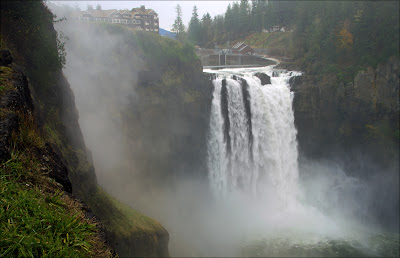Miscellaneous collection of traveling rocks/boulders I've visited in recent weeks. "Glacial" erratics were moved within glaciers. "Ice-Rafted" erratics were carried by icebergs during the Ice Age Floods. Icebergs holding boulders often grounded along the margins of Ice Age flood channels.
Teresa checks out the BIG rock.
We finally found time to visit the Lake Stevens
glacial erratic. This is the largest known erratic left by the Puget lobe of the
Cordilleran Ice Sheet [34' tall, 78' long]. Geology blogger Dave Tucker has more details on the
Lake Stevens Erratic.
Erratic warning sign.
Other side of BIG rock.
A big thumbs up to the surrounding homeowners!!! Nice little park on streetside of Lake Stevens erratic.
Yeager Rock
Example of a glacial erratic on the east side of the Cascades. No moss or ferns! This photo was taken a couple years ago on the Waterville Plateau. Yeager Rock and many other basalt boulders were carried south by the Okanogan lobe of the Cordilleran Ice Sheet.
Wedgewood Erratic
Teresa inspects the Wedgewood Erratic. According to
Wedgewood Erratic Wikipedia page ... This Seattle erratic was an early practice climb location for Jim Whittaker, who became the first American to reach the top of Mount Everest.
"Fantastic Erratic"
A huge erratic south of Lake Sammamish. Too slow with camera ... almost had "Dog for scale" ... he jumped off as I approached.
Should be "Ferntastic". Hard to see the rock.
Teresa Foster enjoys fall hike.
Salmon working hard in Issaquah Creek.
Big flow at Snoqualmie Falls.
Snoqualmie boulders
More on this area in a future post. Great stuff near Twin Falls where ice flowed in from two directions [One from Canada the other from Snoqualmie Pass area].
Use Space Needle to mark maximum Ice Age Flood high water mark? Nope! Too short.
Aircraft beacon on top of Space Needle tower is only 605 feet above ground. The Columbia river normal elevation at Vantage is around 570 feet. Largest Ice Age Floods to sweep through the area had a surface elevation greater than 1,263 feet [Ice-rafted erratics have been found at this elevation by State Park rangers].
Nick and I have met several times in recent weeks near Vantage, WA. We're trying to round up video and photos to build a show featuring geology along Interstate 90 between Seattle and Spokane. The drainage on the other side of the river (above) is Ryegrass Coulee. Several ice-rafted erratics sit in Ryegrass Coulee ... hard to find at 70 mph.
"An Iceberg Graveyard"
Nick at
Ginkgo State Park visitor center - Vantage, WA. Interpretive panels describes ice-rafted erratics stranded high above the Columbia River.
Teresa and Pasco Basin erratics [ice-rafted] last weekend.
Short video describes Ice-Rafted Erratics
Subscribe to HUGEfloods Channel for new video updates.
Ice-rafted erratic in Ryegrass Coulee.
Back to "Glacial Erratics"
Here's Nick between Ellensburg and Cle Elum - Elk Heights I-90 exit in the distance. The boulder was carried to this location by a huge glacier that was fed by ice flowing from Snoqualmie Pass and the drainages that now hold Lake Kachess and Lake Cle Elum.
Glacial moraine near Thorp, WA
I-90 winds through massive moraine that marks maximum advance of glacier mentioned above. The glacier that left this moraine is from a much earlier time than the recent rounds of Lake Missoula flooding. The 40 mile-long Yakima Glacier existed more than 600,000 years ago.
Tabbert grounded by fog
Tom Tabbert flew over from Spokane to help us shoot video of I-90 cutting through the big moraine. Morning fog at the Ellensburg airport delayed Saturday filming.
TTABS got the footage ... after fog lifted.
Tabbert approaches lower moraine.
Niece Abby sits on Ice-Rafted Erratic in Yakima Valley.
Abby and I were on our way to visit Grandma (Mom) & Grandpa (Dad).
Erratic #1 on map below
Erratics along I-82 just north of Exit 44
Can you help?
These erratics are marked #2 on map below. Impressive boulders near Ice Age Floods margin in Yakima Valley. Erratics marked #1 and #2 were probably stranded by the same iceberg and moved to edge of Ag ground? Anyone know the story or name of orchard owner?
Interstate 82 - Exit 44.
Tom Tabbert and Nick Zentner
Killing time near Thorp lahar while waiting for fog to lift at Bowers Field.
Thorp lahar in distance [Red arrow at left end - white band].
Lahar: Mudflow or debris flow composed of a slurry of pyroclastic material, rocky debris, and water. The material flows down from a volcano, typically along a river valley.
Some amazing traveling rocks out here! The lahar near Thorp, WA is really cool. Material flowed to this location from a volcano that no longer exists near White Pass, WA. Obstacles like Manastash Ridge were not in place when the volcano erupted allowing flow from White Pass to Thorp area.
Rode in on the lahar from SW.
Same rock pictured in previous image [above Jeep].
Tabbert takes a look at lahar and Yakima River.
Geologists believe this pink mass of rock rafted in on the lahar.
Nick and Rick Spencer video featuring Thorp lahar.











































































